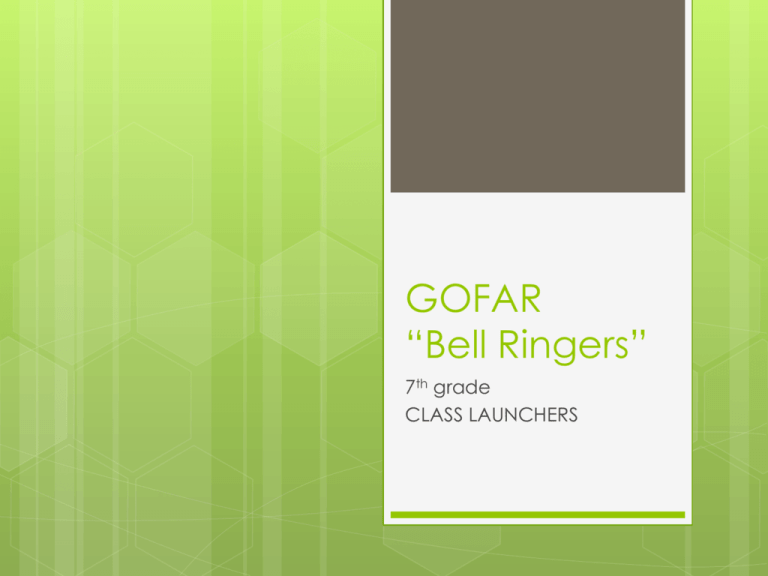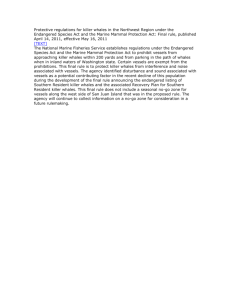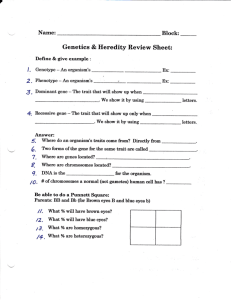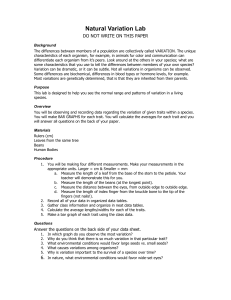Class Launchers
advertisement

GOFAR “Bell Ringers” 7th grade CLASS LAUNCHERS Day 1 Which is an adaptation that makes it possible for the animal to survive in a cold climate? A) tail on a lizard B) scales on a fish C) stripes on a tiger D) fur on a bear Which characteristic distinguishes Bacteria from all other kingdoms of life? A) They are always unicellular. B) They have single cells without a nucleus. C) They move by waving their flagella. D) They can make their own food. Day 2 Which biome is characterized by low temperatures and low amounts of rainfall? A) tundra B) desert C) temperate deciduous forest D) tropical rain forest This family tree shows the relationship among certain primates based on the chemical composition of a protein in their blood. According to this tree, which pair is most closely related? A) spider monkeys and colobus monkeys B) baboons and gorillas C) owl monkeys and spider monkeys D) gorillas and chimps Day 3 What class of animals has the characteristics shown in the list? A) fish B) amphibians C) reptiles D) birds The following are adaptations in amphibians to live on land except A) strong bones and muscles. B) skin that stays moist. C) gills for breathing. D) a complete digestive system. Day 4 Which group needs an aquatic environment to reproduce? A) amphibians B) birds C) mammals D) reptiles Which is a hypothesis? A) Five earthworms died when the soil became too dry. B) Earthworms have a mucous-covered outer surface. C) Heavy rain causes earthworms to move above ground. D) What will happen if an earthworm is cut in two? Day 5 Which bird would have the BEST chance of surviving to reproduce in an environment where the main food source was insects buried deep in the soil? Day 6 According to the table and key, what conclusion can be drawn about the two organisms? Dichotomous Key 1a has nucleus go to 2 1b has no nucleus prokaryote 2a unicellular algae 2b multicellular go to 3 3a cell wall plant 3b no cell wall animal Organism FEATURES Nucleus Number of cells Cell wall 1 Yes Multicellular Yes 2 Yes Multicellular No Day 7 The respiratory system is responsible for bringing oxygen rich air into the body. Which system is responsible for absorbing the oxygen and carrying it throughout the body? A. excretory B. circulatory C. digestive system D. immune system Day 8 Which part of the excretory system regulates the contents of body fluids? A. bladder B. ureter C. kidney D. inferior vena cava Day 9 Thirteen species of finch live on the Galapagos islands. How would different beak structures help the finches on the islands? A. The different beaks lead to more competition for nesting space among the species. B. The different beaks lead to different forms of camouflage among the species. C. The different beaks lead to increased mimicry among the species. D. The different beaks lead to less competition for food among the species. Day 10 Both A. B. C. D. bacteria and animal cells contain Mitochondria Chloroplasts Cytoplasm A nucleus What is the ultimate source of energy received by the large fish in the food web? Decomposer A. Small fish B. The decomposers algae People C. The sun Large Small D. The humans fish fish Day 11 Which of the following is NOT a function of the circulatory system? A. transport of oxygen to cells B. transport of waste from cells to the excretory system C. transport of nutrients from the digestive system to cells D. transport of information from skin cells to the brain Which organ system carries nutrients to cells and aids in removing Wastes from cells? A. nervous B. circulatory C. skeletal D. excretory Day 12 A certain biome has hot summers, cold winters, and year-round precipitation. Which biome is this? A. grassland B. savanna C. temperate forest D. tropical rain forest Rabbits were first brought to Australia in 1859. Since that time, Australia has been overrun by rabbits. Why do non-native Species like Australian rabbits often become overpopulated in their New habitat? A. they have few predators and competitors B. they fit into the new ecosystem better C. They are stronger than the native species D. they breed faster than the existing plants and animals. A florist grew one type of flowering plant for 10 years. Each year, the florist crossbred the plants with the palest blooms and planted their seeds the following year. What is the MOST LIKELY outcome of the florist’s process? A. Each generation of plant made blooms that were less about to photosynthesize. B. Each generation of plant made blooms that were increasingly pale. C. Each generation of plant made blooms that were less resistant to insects. D. Each generation of plant made blooms that were increasingly colorful. Which analogy BEST matches this pair? chapter : book A. system : organ B. organ : cell C. organism : organ D. cell : tissue Which organ system is responsible for the removal of wastes? A. respiratory B. excretory C. endocrine D. nervous In the early 1900s, a scientist named Walter Sutton observed sperm and egg cells through a microscope. He noticed that each sex cell carried only half as many chromosomes as the body cells of the organisms that produced them. Based on this information, which conclusion did Sutton MOST LIKELY make? A. B. C. D. Egg cells cannot fertilize other egg cells. Genetic information doubles each generation. Sperm and egg cells cannot become body cells. Characteristics are transmitted from each parent by chromosomes. Grady want to make a dichotomous key of these animals : bear, snake, lion, eagle. Into what groups could he evenly divide the animals? A. animals with legs and animals without legs. B. animals with fur and animals without fur. C. animals with vertebrae and animals without vertebrae. D. animals with wings and animals without wings. Scientists think that the types of organisms living on Earth have changes over time. Scientists have collected evidence to support this claim by A. studying fossils found in sedimentary rocks. B. studying development of the solar system. C. comparing sedimentary and igneous rocks. Comparing life-forms on Earth to those on Mars. Which of these is an adaptation in which a harmless organisms looks like a harmful organism? A. camouflage B. deception C. mimicry D. venom Which of these communities contains organisms BEST adapted to the ebb and flow of the tides? A. marine B. freshwater C. estuary D. pond Running Trait Black Brown Normal 242 80 ? Waltzing 74 17 ? Total ? ? 413 Mice Hair Color Total have 2 alleles that determine the trait for how they run. Mice with the normal trait can run in a straight line, and mice with the waltzing trait can only run around in circles. Of the 413 mice listed above, how many have the normal trait? a. 91 b. 97 c. 316 d. 322 In what biome would you find elk, moss, and permafrost? A. desert B. Tundra C. Temperate forest D. Tropical rain forest Suppose that two species share the same food source, and at some point the food source becomes rare. Which type of interaction would most likely intensify between the two species? a. Mutualism b. commensalism c. competition d. parasitism Scientists who study fossils have discovered that whale ancestors did not have fins. Instead, they had four legs like dogs. What does this suggest about the ancestors of whales? A. whale ancestors could swim faster than whales today. B. whales evolved from land mammals. C. whales are mammals, not fish. D. whale ancestors were also aquatic mammals. Which organism transfers radiant energy from the sun into chemical energy to be used as food? a. Crab b. Sunflower c. Mushroom d. Clam Which organ of the digestive system absorbs water from waste materials in preparation for defecation (waste removal)? Stomach Small intestine Large intestine Liver One parent has unattached earlobes, which is a dominate trait. The other parent has attached earlobes, which is a recessive trait. What is the probability that an offspring of these parents will have attached earlobes? a. 0% b. 25% c. 50% d. 100% e e E E Which of these involves a person’s muscular and nervous systems? A. a person jumps in reaction to a startling experience. B. Oxygen is absorbed in to the blood and carried throughout the body. C. white blood cells travel to an infected location in the body. D. the stomach produces chemicals to use in digestion. In the male of a particular species, a cell with 20 chromosomes undergoes the type of cell division that produces four sperm cells. How many chromosomes will each sperm cell have? a. 5 b. 10 c. 20 d.40 Which of these produces oxygen as a waste product? A. American beaver B. brook trout C. sugar maple D. Eastern bluebird An oceanographer is investigating whether the number of killer whales off the California coast is declining. What would be the MOST helpful information for the oceanographer to seek first? A. the amount of food available to the killer whales. B. the average size of today’s killer whales as compared to the average size of killer whales 50 years ago. C. the presence of disease among killer whales. D. the number of killer whales today compared to the number of killer whales 50 years ago. Which catastrophic event also returns nutrients such as nitrogen compounds to the soil? A. earthquake B. forest fire C. hurricane D. tornado Mistletoe often grows on the trunks and branches of trees. The roots of the mistletoe burrow into the tree, soaking up water and nutrients. Most trees can support a few mistletoe plants, but a tree with many mistletoe plants will not be as healthy as other trees of its species. Which type of relationship is this? A. parasite-host B. carnivore-herbivore C. predator-prey D. consumer-producer Which process is part of the carbon cycle? A. condensation B. respiration C. precipitation D. Evaporation The New Zealand flatworm was accidentally brought to the United Kingdom in the 1960’s, probably in some potted plants. It now inhabits much of Scotland. Scottish gardeners and farmers consider the New Zealand flatworm a pest because it kills and eats earthworms. Which relationship is this? A. predator-prey B. Parasitism C. Mutualism D. commensalism The suslik is a small animal whose diet consists mainly of grasses, plant stems and leaves, and flowers. In which habitat would the suslik MOST LIKELY be found? A. tundra B. prairie C. forest D. Desert If an organism has chloroplasts in its cells, what would you assume about that organism? a. It is a mammal b. It lives in the rain forest c. It does not respire d. It makes its own food Dr. Johnson identifies a new species of plant that reproduces asexually. Which of the choices below is FALSE? A. the plant’s offspring share all of the parent’s traits. B. the plant’s offspring have all of the parent’s genes. C. the plant’s offspring display a wide range of traits. D. the plant’s offspring look the same as the parent plant. Dimples Widow’s Peak Total Yes No Yes 62 17 79 No ? 8 26 Total 80 25 105 John asked 105 7th grade students in his school if they had a widow’s peak and dimples. How many had a widow’s peak and no dimples? a. 17 b. 18 c. 43 d. 80 Which of these statements about animal cells is false? a. Some animal cells make their own food b. Some animal cells grow and divide to make more cells c. Some animal cells process nutrients to produce energy d. Some animal cells use nutrients to build or repair an organism Which of these orders the organisms from producer to top-level consumer? A. algae-- bass -- shrimp larvae-- crayfish B. bass -- crayfish -- shrimp larvae --algae C. shrimp larvae – algae-- bass-- crayfish D. algae -- shrimp larvae --crayfish – bass The monarch butterfly and the Viceroy butterfly look alike. The monarch tastes bad, so birds do not eat it. The Viceroy tastes good, but the birds avoid it. What adaptation is this? A. camouflage B. natural selection C. mimicry D. concealment Use the dichotomous key to answer. Suzanne went bird watching And spotted two different types of birds. She listed their characteristics in the table. Using the dichotomous key, what kind of bird is Bird 2? A. Blue jay Features B. Seagull BIRD Size Color C. Sparrow 1 Small Brown D. hawk 2 Large Brown Beak straight curved The black walnut tree makes a chemical that is toxic to many other plants. This chemical keeps other plant species away from the black walnut. Which term best describes the relationship between a black walnut and other plant species? A. competition B. mutualism C. commensalism D. parasitism





